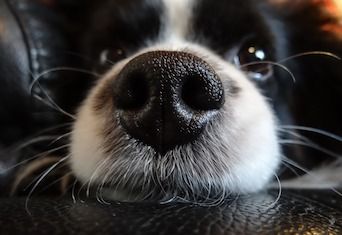Exploration of a Working Dog's Nose
How do health, overall management, and the microbiota affect the function of a working dog’s nose?

A dog’s sense of smell is 10,000 to 100,000 times greater than that of humans. This superior olfaction is especially important for working dogs, such as those that work in law enforcement and the military. However, little is currently known about how health, management, and the microbiota impact canine olfaction.
A recent Frontiers in Veterinary Science review paper discussed olfaction anatomy and physiology and influences on a working dog’s olfaction.
Olfaction Anatomy and Physiology
The canine olfactory system contains the nasal cavity, olfactory epithelium, vomeronasal organ, and olfactory bulb. The nasal cavity has 3 nasal turbinates that increase mucosal surface area. The olfactory epithelium has constantly regenerating olfactory receptor cells, each containing hundreds of cilia that facilitate superior odor detection; importantly, each olfactory receptor cell has only 1 type of olfactory receptor.
RELATED:
- Can Sniffing Behavior Help Dogs Recognize Themselves?
- Are Canine Cancer Sniffers the Real Deal?
The vomeronasal organ detects nonvolatile odorants, such as pheromones, that influence social behavior. The olfactory bulb filters sensory input and communicates with the cerebral cortex. This communication underlies the importance of the memory of smell in working dogs, the durability of which can depend on training methods.
When a dog sniffs, air flows in the front and out the side of the nose, allowing for efficient air sampling. Each nostril intakes air separately, with sensory input going to the ipsilateral side of the brain (eg, right nostril, right brain hemisphere). The right nostril sniffs conspecific and new odors and the left nostril sniffs familiar and nonaversive odors.
Influence #1: Health
Genetics is believed to significantly affect canine olfaction, with olfactory receptor gene polymorphism potentially playing a role in olfactory ability and sensitivity differences between individuals and breeds.
Canine hyposmia (reduced smelling ability) can be caused by many diseases, but its true incidence is unknown. For example, heat stress can cause panting, which decreases odor detection efficiency. Viral diseases like canine distemper cause nasal inflammation, thus altering normal air flow within the nasal cavity. Head trauma and endocrine disease (eg, hyperadrenocorticism) can also reduce olfaction.
Various pharmaceuticals such as steroids and metronidazole can cause hyposmia. Information on pharmaceutical-induced canine hyposmia is drawn primarily from human medicine.
Influence #2: Management
“Maximizing olfactory function should be paramount in decisions regarding detection dogs,” wrote the review paper’s authors. Proper management can help maximize this function. For example, a working dog maintained in optimal physical condition has a lower exercising heart rate, leading to less panting and improved olfaction. In addition, scent detection training techniques can improve odor sensitivity and discrimination. Interestingly, fasting may improve olfaction.
Influence #3: Microbiota
The microbiota is the bacterial portion of the microflora. Whether microbiota alterations affect working dog health and performance is unknown. However, gut microbial dysbiosis, which is associated with chronic gastrointestinal (GI) inflammation, can be affected by environmental changes and physical exertion—stresses commonly experienced by working dogs. Dietary modifications, such as administration of synbiotics (prebiotics and probiotics), could reduce GI distress and help working dogs in the field.
Notably, olfactory receptors have been identified in the GI tract and affect serotonin secretion; serotonin regulates olfactory information processing, suggesting a link between GI microbiota and olfaction. In addition, previous research has identified a link between nasal microbiota and olfactory performance.
For the Future
Even with this current knowledge on factors influencing working dog olfaction, many questions remain. “The critical impact of the work conducted by these canines requires much deeper understanding of all things that could hinder their job performance,” the authors concluded.
Dr. JoAnna Pendergrass received her doctor of veterinary medicine degree from the Virginia-Maryland College of Veterinary Medicine. Following veterinary school, she completed a postdoctoral fellowship at Emory University’s Yerkes National Primate Research Center. Dr. Pendergrass is the founder and owner of JPen Communications, a medical communications company.